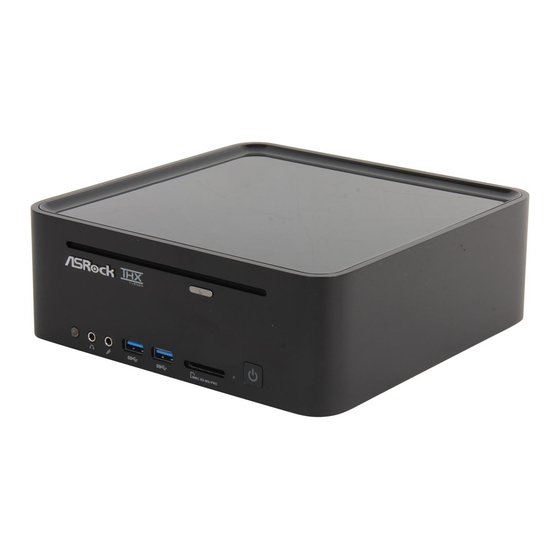
ASROCK Vision HT Installation And Configuration Manual
Sata hard disks installation and raid configuration
Hide thumbs
Also See for Vision HT:
- User manual (63 pages) ,
- Installation manual (4 pages) ,
- Quick manual (2 pages)
Table of Contents
Advertisement
Quick Links
Guide to SATA Hard Disks
Installation and RAID Configuration
1.
Guide to SATA Hard Disks Installation ............................ 2
1.1
Serial ATA (SATA) Hard Disks Installation ............... 2
2.
Guide to RAID Configurations ......................................... 3
2.1
Introduction of RAID ............................................... 3
2.2
RAID Configuration Precautions ............................ 5
2.3
64-bit With RAID Functions .................................... 6
2.4
Setting the BIOS RAID Items .................................. 7
2.5
Configuring the Intel RAID BIOS ............................. 7
2.6
Deleting RAID Volume .......................................... 11
®
1
Advertisement
Table of Contents

Summary of Contents for ASROCK Vision HT
-
Page 1: Table Of Contents
Guide to SATA Hard Disks Installation and RAID Configuration Guide to SATA Hard Disks Installation ......2 Serial ATA (SATA) Hard Disks Installation ....2 Guide to RAID Configurations ......... 3 Introduction of RAID ..........3 RAID Configuration Precautions ......5 ®... -
Page 2: Guide To Sata Hard Disks Installation
Guide to SATA Hard Disks Installation 1.1 Serial ATA (SATA) Hard Disks Installation Intel HM77 chipset supports Serial ATA (SATA) hard disks with RAID functions, including RAID 0, RAID 1 and Intel Rapid Storage. Please read the RAID configurations in this guide carefully. You may install SATA hard disks on this motherboard for internal storage devices. -
Page 3: Guide To Raid Configurations
Guide to RAID Configurations 2.1 Introduction of RAID This motherboard adopts Intel HM77 chipset that integrates RAID controller supporting RAID 0 / RAID 1/ Intel Rapid Storage function with four independent Serial ATA (SATA) channels. This section will introduce the basic knowledge of RAID, and the guide to configure RAID 0 / RAID 1/ Intel Rapid Storage settings. - Page 4 Intel Rapid Storage The Intel Rapid Storage technology supported allows you to create a RAID 0 and RAID 1 set using only two identical hard disk drives. The Intel Rapid Storage technology creates two partitions on each hard disk drive to create a virtual RAID 0 and RAID 1 sets. This technology also allows you to change the hard disk drive partition size without losing any data.
-
Page 5: Raid Configuration Precautions
2.2 RAID Configurations Precautions Please use two new drives if you are creating a RAID 0 (striping) array for performance. It is recommended to use two SATA drives of the same size. If you use two drives of different sizes, the smaller capacity hard disk will be the base storage size for each drive. -
Page 6: Installing Windows
2.3 Installing Windows ® 7 / 7 64-bit / Vista Vista 64-bit With RAID Functions If you want to install Windows ® 7 / 7 64-bit / Vista / Vista 64-bit on your SATA HDDs with RAID functions, please follow below steps. STEP 1: Set up UEFI. -
Page 7: Setting The Bios Raid Items
2.4 Setting the BIOS RAID Items After installing the hard disk drives, please set the necessary RAID items in the BIOS before setting your RAID configuration. Boot your system, and press <F2> key to enter BIOS setup utility. Highlight Advanced and press <Enter>, then the main interface of BIOS setup utility will appear. - Page 8 Volume0 In the Create Volume Menu, under Name item, please key-in a unique name with 1-16 letters for your RAID volume then press <Enter>. Volume0 Use the up or down arrow keys to select your desired RAID Level. You may select RAID0 (Stripe), RAID1 (Mirror), or Rapid Storage for your RAID level.
- Page 9 Volume0 If you selected RAID 0 (Stripe), use the up or down arrow keys to select the stripe size for your RAID 0 array then press <Enter>.The available values range from 8 KB to 128 KB. The default selection is 128 KB.
- Page 10 Volume0 Press <Enter> under the Create Volume item. The utility prompts a confirmation message as below. Volume0 Press <Y> to complete the setup of RAID. After the completion, you will see the detailed information about the RAID that you set up.
-
Page 11: Deleting Raid Volume
Please note that you are only allowed to create one RAID partition at a time under BIOS RAID environment. If you want to create extra RAID partition, please use the RAID utility under Windows environment to configure RAID functions after you install OS. 2.6 Deleting RAID Volume If you want to delete a RAID volume, please select the option Delete RAID Volume, press <Enter>, and then...
















Need help?
Do you have a question about the Vision HT and is the answer not in the manual?
Questions and answers